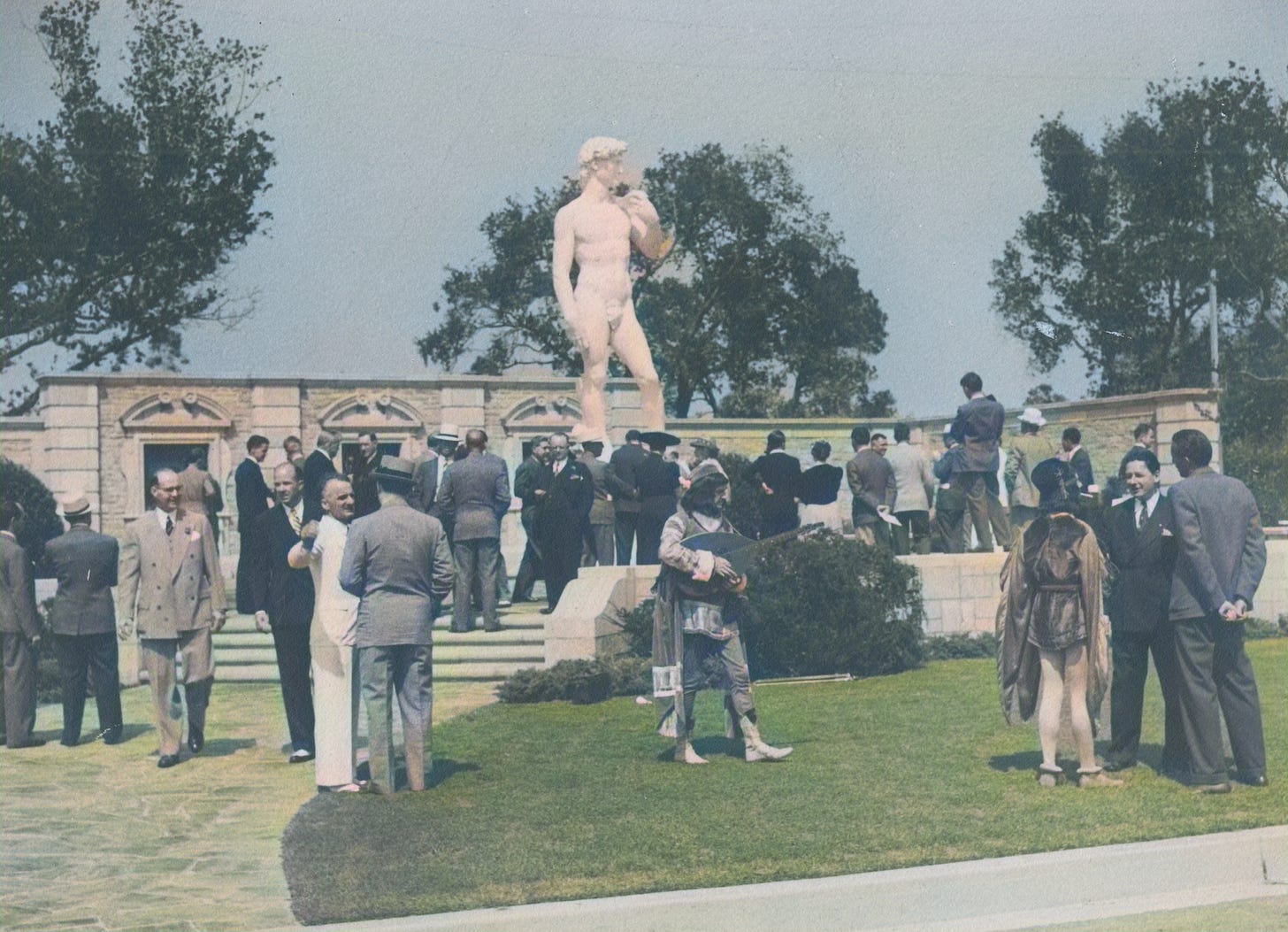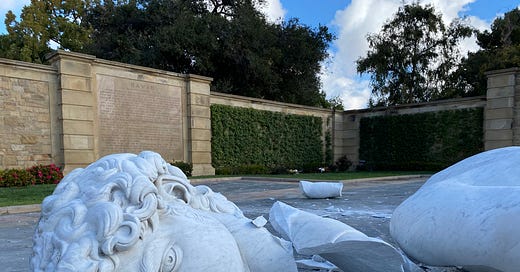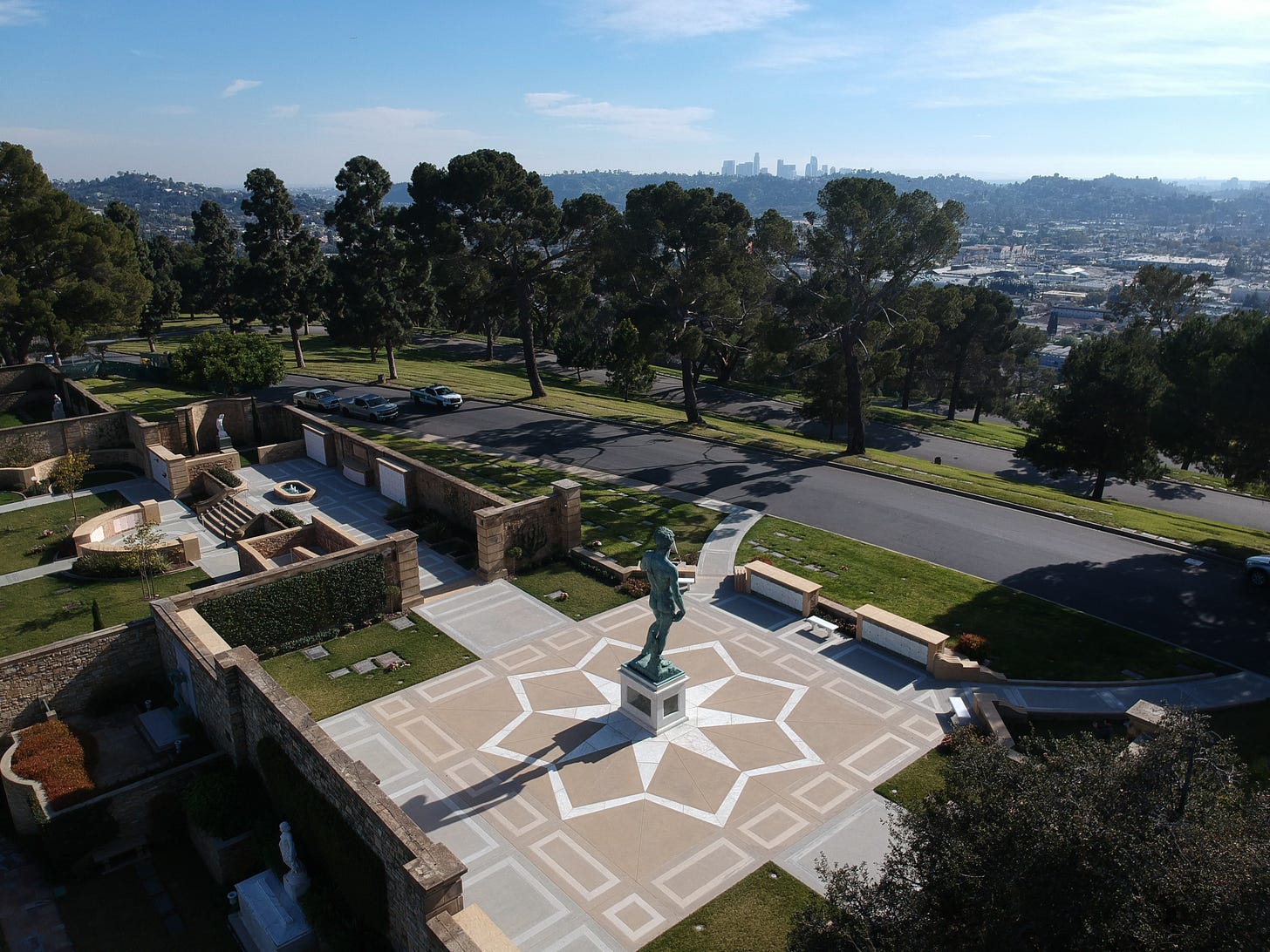Free Art Friday: Michelangelo’s David in Glendale
James Fishburne, Art Muse Lecturer & Director of Forest Lawn Museum
Every art lover knows that Michelangelo’s most famous sculpture, his iconic David, resides in Florence, Italy. But if you’re in Southern California, you don’t need to book a flight to see the 17-foot-tall statue, because a full-scale replica of the artwork is on permanent display at Forest Lawn-Glendale. Standing like a sentinel atop the memorial park, he surveys the landscape with the skyline of Los Angeles visible in the distance.
Forest Lawn has one of the world’s largest collections of Michelangelo replicas, and the institution have been collecting them for exactly 100 years. Their first replica, Moses, was sculpted in 1924 by Oreste Andreini in his Florentine studio. Moses was quickly followed by other Michelangelos, including the Vatican Pietà, Night, Day, Twilight, Dawn, and the Bruges Madonna. All of the replicas were sculpted using Carrara marble, which is the same type of stone used by Michelangelo. Of course, no collection of Michelangelo replicas would be complete without David. Forest Lawn’s was sculpted in 1937 and was unveiled in 1939 to much fanfare. They hosted an elaborate event, complete with Italian musicians dressed in Renaissance attire.

Sadly, David met his match in 1971 when he was toppled by an earthquake. He was replaced but fell again in 1994. He fell once more in 2020, even though he was on a seismically isolated base. Realizing the problem was not going away, Forest Lawn commissioned a bronze David, which was installed in 2021. This material was chosen for practical and historical reasons. Bronze has greater tensile strength than marble, so it won’t crack and fall during an earthquake. While Michelangelo primarily sculpted in marble, he did occasionally work in bronze. Famously, he created a bronze portrait of Pope Julius II for the cathedral in Bologna. When the city was sacked by the pope’s adversaries, they melted down the portrait to make a cannon, which they named La Giulia, in an effort to mock the pontiff.
Forest Lawn was not the first site to commission a bronze David. The city of Florence has their own bronze version of the biblical figure. The sculpture was added to Piazzale Michelangelo in 1875 in honor of Michelangelo’s 400th birthday. The picturesque space overlooks the Arno River with the dome of Florence cathedral in the distance. In fact, Forest Lawn’s Court of David was inspired by Piazzale Michelangelo. Even the patina chosen for Forest Lawn’s new David is meant to evoke the green surface of Florence’s bronze sculpture.
The Court of David celebrates Michelangelo’s entire career. Behind the statue is a trio of bronze bas-reliefs commissioned by Forest Lawn in the 1930s. The left and right scenes honor the biblical figure of David, while the central scene depicts Michelangelo in his studio showing off the statue of David to Florentine elites. To the right of these bas-reliefs is a marble replica of the Madonna of the Stairs, which was the earliest work Michelangelo ever created. To the left is a marble rendering of a sibyl, which is an ancient oracle, painted by Michelangelo on the Sistine chapel ceiling. The paving was redesigned in 2021 as Forest Lawn prepared to install the new statue of David, and it too is an homage to Michelangelo. It features a multi-pointed star made of inlaid marble that is inspired by a piazza in Rome, called the Campidoglio, which was designed by Michelangelo in 16th century.
Visitors often ask why Forest Lawn’s marble Davids fell, when the original David is still standing. After all, Florence, like Southern California, is prone to earthquakes. I’ve spent a lot of time pondering the question. One possible reason is that every block of marble is unique. The grain of the stone and tiny blemishes within the material differ from one piece to the next. Perhaps more important is the fact that Michelangelo carved David in central Florence. The figure was moved several hundred feet to his initial home in front of the Palazzo Vecchio, where he stood for centuries, then he was moved only once more to the Galleria dell'Accademia in 1883, which is located less than a mile away. Any marble replica created for export will need to be moved from a studio, to a port, to a ship, to a port, and finally to its new home. This trip would stress the block of marble, possibly creating microscopic fissures within the stone. If you’d like to take a look at what remains of Forest Lawn’s first marble David, his head and foot are on view in Forest Lawn Museum. Placed on a low plinth, you can get within inches of the massive fragments and truly appreciate the size and details of Michelangelo’s colossal masterpiece.







Where does the bronze replica come from?
James, your article is so interesting, packed with historical, fun facts re: Forest Lawn's David and Michelangelo's oeuvre!
I enjoyed learning about the bronze portrait of Julius II for the Bologna Cathedral and its meltdown which resulted in the making of a cannon, ironically named "La Giulia".
Regarding Forest Lawn's marble David falling and breaking on a few occasions, I agree with the fact that the marble went through lots of stress from its point of origin to shipping and then to installation.
The image of Forest Lawn's fallen marble David's head looks like it's from an archaeological dig - an artifact! Can't wait to come see it.